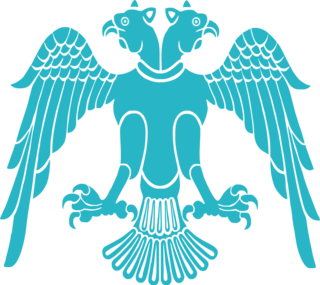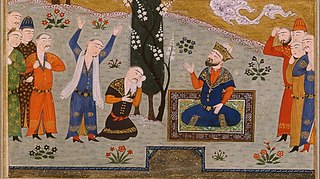Related Research Articles

Abu Shuja Ghiyath al-Dunya wa'l-Din Muhammad ibn Malik-Shah, better known as Muhammad I Tapar, was the sultan of the Seljuk Empire from 1105 to 1118. He was a son of Malik-Shah I and Taj al-Din Khatun Safariya. In Turkish, Tapar means "he who obtains, finds".

Abū al-ʿAbbās Aḥmad ibn al-Hasan al-Mustaḍīʾ, better known by his laqabal-Nāṣir li-Dīn Allāh or simply as al-Nasir, was the Abbasid caliph in Baghdad from 1180 until his death. His laqab literally can mean The One who Gives Victory to the Religion of God. He continued the efforts of his grandfather al-Muqtafi in restoring the caliphate to its ancient dominant role and achieved a surprising amount of success as his army even conquered parts of Iran. According to the historian, Angelika Hartmann, al-Nasir was the last effective Abbasid caliph.
Sayyida Shirin, also simply known as Sayyida (سیدا), was a Bavandid princess, who was the wife of the Buyid amir (ruler) Fakhr al-Dawla.

Anvari (1126–1189), full name Awhad ad-Din 'Ali ibn Mohammad Khavarani or Awhad ad-Din 'Ali ibn Mahmud was a Persian poet.

Rukn al-Din Abu'l-Muzaffar Berkyaruq ibn Malikshah, better known as Berkyaruq (برکیارق), was the fifth sultan of the Seljuk Empire from 1094 to 1105.
Khwarazmshah was an ancient title used regularly by the rulers of the Central Asian region of Khwarazm starting from the Late Antiquity until the advent of the Mongols in the early 13th-century, after which it was used infrequently. There were a total of four families who ruled as Khwarazmshahs—the Afrighids (305–995), Ma'munids (995–1017), the line of Altuntash (1017–1041), and the most prominent ones, the Anushteginids (1097–1231). Like other contemporary Central Asian titles, such as Afshin and Ikhshid, the title of Khwarazmshah is of Iranian origin.
Jalal-ud-Din Sultan-Shah, known as Sultan-Shah was a claimant to the title of Khwarazmshah from 1172 until his death. He was the son of Il-Arslan.

The Seljuk dynasty, or Seljukids, also known as Seljuk Turks, Seljuk Turkomans or the Saljuqids, was an Oghuz Turkic, Sunni Muslim dynasty that gradually became Persianate and contributed to the Turco-Persian tradition in the medieval Middle East and Central Asia. The Seljuks established the Seljuk Empire (1037–1194), the Sultanate of Kermân (1041–1186) and the Sultanate of Rum (1074–1308), which at their heights stretched from Iran to Anatolia and were the prime targets of the First Crusade.

Il-Arslan was the Shah of Khwarezm from 1156 until 1172. He was the son of Atsïz.
Qutb ad-Din Muhammad was the first Shah of Khwarezm from 1097 to 1127. He was the son of Anushtegin Gharchai.

The Bavand dynasty, or simply the Bavandids, was an Iranian dynasty that ruled in parts of Tabaristan in what is now northern Iran from 651 until 1349, alternating between outright independence and submission as vassals to more powerful regional rulers. They ruled for 698 years, which is the second longest dynasty of Iran after the Baduspanids.
Mu'ayyid al-Din Ai-Aba was the amir of Nishapur from c. 1154 until his death. Although nominally subservient to the Seljuks of Khurasan, he acted as an independent ruler. Due to his control of much of Khurasan, the historian Ibn Funduq called him "Emperor of Khurasan, King of the East."
Ïnanch Sonqur (Turkic) or Husam al-Din Sunqur Inanj was the Seljuk amir of Ray from 1160 at the latest until his death. During his eight years in power he played a major role in the events that occurred in northern Iran.
Arslan-Shah of Ghazna was the Sultan of the Ghaznavid Empire from 1116 to 1117 C.E.
The Khwarazmian or Khwarezmian Empire was a culturally Persianate, Sunni Muslim empire of Turkic mamluk origin, that ruled large parts of present-day Central Asia, Afghanistan, and Iran in the approximate period of 1077 to 1231, first as vassals of the Seljuk Empire and the Qara Khitai, and from circa 1190 as independent rulers, up until the Mongol conquest in 1219–1221.

Shahriyar IV, also known by his honorific title Husam al-Dawla, was the king of the Bavand dynasty of Mazandaran, ruling from 1074 to 1114.

Athir al-Din Akhsikati was an Iranian writer, whose ghazals in Persian played an important role in the development of the genre.
Ardashir I, was the ruler of the Bavand dynasty from 1173 to 1205. He was the son and successor of Hasan I.

Shah Ghazi Rustam, was king of the Bavand dynasty of Mazandaran, ruling from 1142 to 1165. He expanded the borders of the kingdom at the expense of his neighbors, particularly the Ismailis and the Seljuks. He established a Bavandid presence in Gilan as a result of his frequent vengeful raids against the Ismailis, who had assassinated his son and heir, Girdbazu. He also brought Qumis and Ray under Bavandid control during his wars against the Seljuks and the Karakhanids.
Tughril II was the Sejluk sultan of Persian Iraq briefly in 1132. He maintained power through the support of his uncle, the principal Seljuk sultan Ahmad Sanjar ; when the latter left for Transoxiana to suppress a rebellion in 1132, Tughril II lost Iraq to his rival and brother Ghiyath ad-Din Mas'ud. Tughril II briefly took refuge in the domain of the Bavandid ispahbad (ruler) Ali I in Mazandaran, where he stayed during the whole winter of 1132–1133. He subsequently captured the capital Hamadan, but was stricken with sickness and died on his arrival to the capital, in October/November 1134. Tughril II was survived by his son Arslan, who was raised by the atabeg Eldiguz, who installed him on the throne in 1161.
References
- "Al-E Bavand." Encyclopaedia Iranica Online. Encyclopædia Iranica. 2 February 2008. <http://www.iranicaonline.org/articles/al-e-bavand>
- Bosworth, C. E. (1968). "The Political and Dynastic History of the Iranian World (A.D. 1000-1217)". In Boyle, J. A. (ed.). The Cambridge History of Iran Volume 5. Great Britain: Cambridge University Press. ISBN 978-0-521-06936-6.
- "Il-Arslan, Abu'l-Fath." Encyclopaedia Iranica Online. 2004. Encyclopædia Iranica. 2 February 2008. <http://www.iranicaonline.org/articles/il-arslan>